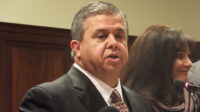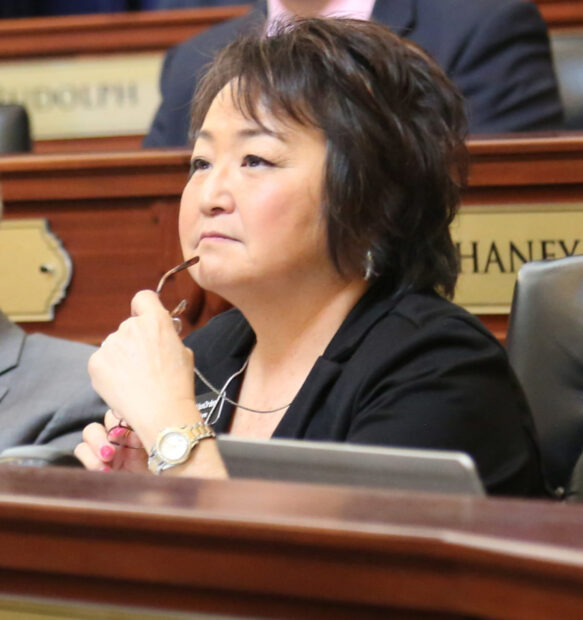Editor’s Note: Public school finance head Tim Hill was the subject of one of Idaho Education News’ earliest well-read features. “Tim Hill is a funny guy” was published Jan. 16 2013, days after Idaho Education News was founded. Hill retires on Friday after 23 years with the State Department of Education.
Tim Hill froze the first time he saw a payment request. This was millions of dollars, after all. So much money it didn’t seem real.
Just a bunch of numbers on a piece of paper, really.
On that September day 23 years ago, Hill was a newbie in the public school finance shop at the State Department of Education.
As part of his new job, Hill needed to sign off on the advance payment request so schools could get their funding.
His boss had already calculated the next two payments.
Hill just needed to sign the paper. Gulp!
“I look at these three-digit, millions of dollars of payments and my heart sunk. It’s like, ‘Oh my gosh I hope this is right because I have no idea what I am doing yet.’ So that stayed with me 23 years later,” Hill said.
Hill, a former banker who found public school finance after the bank where he worked was bought out, quickly learned what he was doing.
Less than a year after joining the SDE on Sept. 8, 1997, Hill was promoted to become bureau chief of school finance.
In 2005, he was named deputy superintendent of public school finance and transportation.
He’s served under four superintendents of public instruction — Anne Fox, Marilyn Howard, Tom Luna and now Sherri Ybarra.
He served under elected officials from both political parties; Howard was a Democrat sandwiched between Republicans. During his career Hill worked hard to remain politically independent. He said he never affiliated with a political party or put up campaign signs in his yard.
At some point, Hill became the face of school funding for Idaho.
Through his budget presentations, Hill interacted with thousands of educators, school administrators, trustees, legislators and stakeholders.
Along the way, Hill became famous for his ability to blend humor and financial acumen in an effort to get people to pay attention to budget presentations and spreadsheets.

“He always had his one-liners,” Luna said. “He always opened with something funny or catchy and he had a dry sense of humor that was embedded in his presentations.”
April Burton, chief financial officer for the Caldwell School District, referenced a vintage television commercial (When EF Hutton talks, people listen) when reflecting on Hill’s presentations.
“He has been the constant we have needed throughout the years,” Burton said. “Always a reliable source of information. Someone we trust, someone we know is looking out for districts and making sure we receive all the funding we are entitled to, based on current legislation.”
“When Tim speaks,” Burton added. “People listen.”
“It’s truly the end of an era, and Tim leaves big shoes to fill,” Ybarra said in a news release this week.
Public school funding is Idaho’s largest expense every year, amounting to about 49 percent of all general fund spending.
Today, that means $2 billion divided up between 115 school districts and more than 50 charter schools with a host of variables that includes more than 300,000 students, almost 20,000 teachers and a school funding formula that is legendary for its complexity.
That’s a Monday morning for Hill, and he knows it’s a serious responsibility.
He took two lessons forward after he froze that day in 1997. He said he reflected back on them through his entire career.
The first is what his team calls the test of reasonableness.
Before approving large payment requests, they search for outliers. Who jumped big? Who dropped off significantly Can they answer the question “why?”
“The test of reasonableness really came true,” Hill said. “We’re always going to find big stuff. The little stuff will find its way after we get the payments made and everybody starts getting in the weeds.”
The second was the paycheck test.
Hill found it to be remarkably effective as well.
“It’s really hard, when you look at that amount of money and you see a whole bunch of numbers on paper it just doesn’t seem like real money,” Hill said. “We realize that it’s going to trickle out and eventually show up in someone’s paycheck.”
Hill’s bosses and colleagues noticed his attention to detail.
“His understanding of the funding formula and education policy is just unparalleled and I relied on it always when making decisions,” Luna said, saying he still views Hill as a personal friend.
“Tim was a great resource to have when you were doing budgets,” said Julie VanOrden, the former House Education Committee chairwoman. “I remember talking to him about what would and wouldn’t work if we’re going to try to change things. He has a lot of institutional knowledge that was very helpful.”

Hill, 64, retires Friday.
This week, the SDE announced Hill’s longtime colleague, Julie Oberle, will serve as his successor. Oberle has worked with Hill since nearly the beginning, starting about five months after Hill.
“He’s been a phenomenal boss,” Oberle said in a written statement. “I’ve learned so much working with Tim, and I can’t thank him enough for his encouragement, support and guidance during our 22 years together.”
Four questions on Idaho education history
What is the most momentous changes you have seen in education?
Hill: “The career ladder for teachers and pupil service staff, which increased state distributions by $215 million from FY 2016 to FY 2020. As significant as this was, school districts continue to face the challenge of raising additional local property taxes through supplemental levies to attract and retain teachers and pupil service staff, who are in high demand. Charter Schools do not have any taxing authority.”
What issue has attracted the most public interest at a meeting?
Hill: “Proposed changes to Idaho’s public school funding formula. School district superintendents, charter school administrators, business managers and representatives from education stakeholder groups testified to the Legislative Education Committees regarding proposed changes during the previous Legislative sessions. There appeared to be majority support in retaining the career ladder, which correlates distributions with the staff placed on the residency and professional rungs. This is one of three attributes of the current funding formula. The second attribute addresses size (in average daily attendance), which provides sufficient funds to hire a teacher for smaller class size, while the third provides varying amounts of funds for each of the categories of students (kindergarten, elementary, secondary, exceptional, and alternative), each of which have different costs.”
What is one thing you never thought you would see in public education?
Hill: “Replacing the maintenance and operations (M & O) property tax with a sales tax increase. Although Governor Risch and the Legislature did respond to those demanding property tax relief in 2006, this replacement removed the equalization component of the funding formula, which took local M & O property taxes into consideration when distributing state funds. In FY 2020, 92 of 115 school districts generated $214 million in additional local property taxes through supplemental levies. This compares with 57 school districts generating $77 million in FY 2006.”
What is the biggest challenge education has gone through?
Hill: “Coronavirus pandemic. This caused school districts and charter schools to, on short notice, figure out how to educate students at home. Although moving from an attendance-based funding formula to an enrollment-based funding model has been recommended (2013 Governor’s Task Force) and discussed for several years, it makes sense to make this move sooner than later, due to the current education environment. This change can be made, regardless of whether or not the funding formula is changed.”
